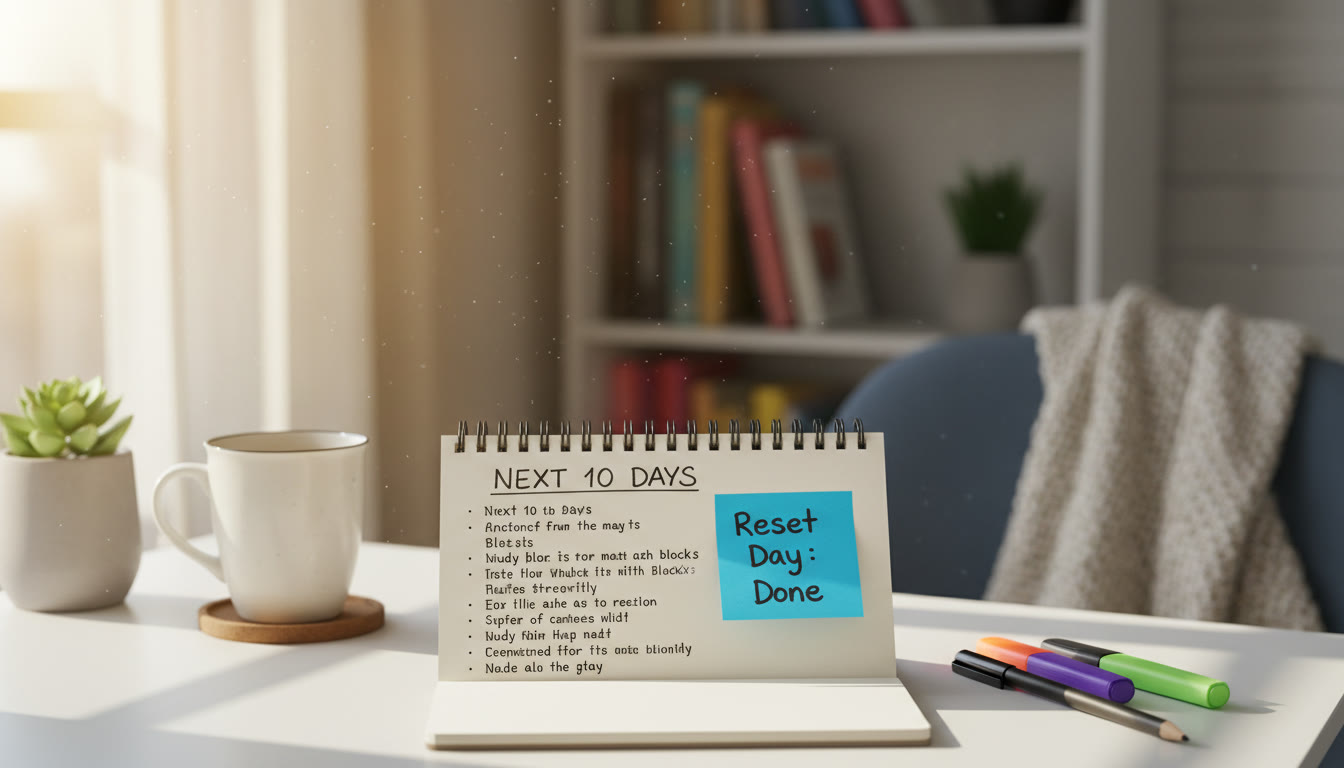Reset Days: Why They Matter for AP Students
When you’re deep in AP season, it can feel like the world narrows down to chapters, practice exams, and the ticking calendar. Burnout sneaks up slowly — first it’s a fog during morning review, then motivation wanes, and before you know it, focus is replaced by dread. That’s where Reset Days come in: intentional respites designed to restore cognitive energy, sharpen motivation, and help you return to study with better strategies, not just more caffeine.

What is a Reset Day?
A Reset Day is a planned, restorative break from intense study where you focus on physical recovery, mental decluttering, and simple, strategic planning. It isn’t a wasted day — it’s an investment. Instead of pushing through exhaustion and producing diminishing returns, you step back so your next stretch of work is more focused, efficient, and creative.
Why Reset Days Work (Science in Plain Language)
- Decision fatigue: Your brain has a daily budget for willpower and cognitive control. Resetting refills that budget.
- Memory consolidation: Rest and varied activity help your brain move what you studied into longer-term memory.
- Motivation restoration: Doing meaningful, low-stress activities reminds your brain why you care about the goals behind the grind.
How to Know You Need a Reset Day
Not every slump demands a full Reset Day. Use this quick checklist — if three or more apply, schedule one within the next 48 hours:
- You can’t get through 30 minutes of study without checking your phone.
- Your notes look like scribbles and you can’t explain them aloud.
- You’re procrastinating on important practice tests.
- You feel physically drained: aching head, sleep that doesn’t refresh, or appetite changes.
- Your mood is flat or irritability has increased around small things.
Designing a Reset Day That Actually Works
Reset Days aren’t one-size-fits-all. The most effective ones are intentional, balanced, and short enough to avoid guilt — usually a single day (24 hours) or a long afternoon when schedules are tight. Below is a framework you can adapt depending on your obligations: school, family, or extracurriculars.
Core Principles
- Plan it: Put the Reset Day on your calendar like an appointment.
- Protect it: Tell one person (a friend, parent, or tutor) you’re taking this time so you’re less likely to cancel at the first stress spike.
- Balance activity: Combine physical movement, low-demand mental work, social connection, and rest.
- Reflect and plan: End the day with a 20–30 minute planning session for the next study block.
Sample Reset Day Schedule
| Time | Activity | Purpose |
|---|---|---|
| 8:00–9:00 AM | Sleep in a bit, gentle stretching, protein breakfast | Physical recovery and gradual wake-up |
| 9:30–11:00 AM | Outdoor walk or light exercise | Boost mood and circulation; clear fog |
| 11:30–1:00 PM | Creative or social activity (art, coffee with a friend) | Recharge intrinsic motivation |
| 1:30–3:00 PM | Low-intensity academic work (review flashcards, organize notes) | Gentle re-engagement without pressure |
| 3:30–5:00 PM | Mindful rest (meditation, nap, reading fiction) | Memory consolidation and energy restoration |
| 6:00–7:00 PM | Reflection and planning session | Turn rest into productive next steps |
Micro Reset Days (When You Can’t Spare a Full Day)
Got a 3-hour break between activities? You can still reset. Try a 90-minute active-rest block: 20 minutes movement, 30 minutes social/creative time, 30 minutes low-stakes review, 10 minutes reflection.
Practical Reset Day Activities for AP Students
Here are specific activities that combine rest with strategic maintenance of study momentum.
Physical Reset
- Go for a brisk 30–45 minute walk without headphones. Let your mind wander — this is mental decluttering, not a podcast session.
- Try gentle yoga or mobility work to relieve the neck and shoulders from hours of hunching over textbooks.
- Prioritize hydration and a balanced meal. Avoid a sugar crash disguised as “treats.”
Mental Reset
- Read something for pleasure (fiction, comics, or a magazine). Reading for fun restores the joy of ideas.
- Do a creative project: sketch, cook a new recipe, or write a short, silly story. Creativity reignites curiosity — the same engine that helps with learning.
- Use a 5–10 minute breathing or grounding practice to lower stress hormones and sharpen focus.
Strategic Academic Reset
This is the bridge between rest and efficient study — not full-on cramming.
- Organize your notes: tidy the messy sections so you don’t waste time next study session.
- Do a low-stakes review like flashcards or a single practice passage — aim for accuracy, not speed.
- Set 3 clear goals for the next focused block: one content goal, one practice goal, and one wellbeing goal (like sleep by 11:00 PM).
How to Use Reflection to Make Reset Days Stick
Reset Days are powerful because they include an ending: a short reflection that turns recovery into strategy. Spend 20–30 minutes answering these prompts in a notebook or on your phone:
- What felt like the big drain last week? (List two things.)
- What small changes would reduce that drain? (Actionable next steps.)
- What will I do differently in the next study block to safeguard energy?
From those answers, create a simple checklist for the following week: 3 study goals, 2 rest habits, and 1 accountability check (e.g., a 10-minute check-in with a tutor or study buddy).
Real-World Example: Maya’s Reset Strategy
Maya is an AP Biology student juggling club commitments and family responsibilities. After two weeks of late-night studying, she hit burnout: her practice test scores plateaued and she felt numb. On her Reset Day she did three things differently:
- She scheduled the day and told her mom so chores were covered.
- She took a long walk, prepared a healthy lunch, and spent an hour painting — a hobby she missed.
- She spent 25 minutes organizing her notes and wrote three concrete goals for the next 10 days.
Result: Maya returned to studying with clearer priorities, better sleep, and two points improvement on the next practice quiz because she used her energy more efficiently.
Reset Day Tools and Routines That Save Time
Small tools can make Reset Days quicker and more effective.
- Use a 15-minute timer app for focused reflection — short bursts beat foggy, open-ended thinking.
- Maintain a dedicated “Reset playlist” with relaxed, instrumentals to cue your brain into rest mode.
- Keep a simple planner template: today’s wins, tomorrow’s 3 priorities, sleep target.
When to Schedule Reset Days During the AP Year
Timing matters. Here are practical windows when Reset Days pay the highest dividends:
- After a full-length practice exam: Use a Reset Day the following day to recover and analyze mistakes calmly.
- Between grading periods or large projects: A Reset Day helps you shift focus and avoid carryover stress.
- When signs of burnout first appear: Early resets prevent a deeper slump that costs weeks of productivity.
How Personalized Support Amplifies Reset Days
Reset Days are most effective when paired with targeted guidance. That’s where personalized tutoring helps: a tutor can identify the exact weak points to address after a Reset Day, build a tailored study plan that matches your renewed energy, and provide accountability for the next stretch.
Sparkl’s personalized tutoring offers 1-on-1 guidance, tailored study plans, expert tutors, and AI-driven insights that help you convert the calm of a Reset Day into measurable improvement. Think of a Reset Day as refueling — tutors turn that fuel into a guided route forward.
Common Mistakes to Avoid
- Turning a Reset Day into passive scrolling: Active rest beats passive doomscrolling every time.
- Using Reset Days as an excuse to procrastinate: They should be planned, not reactive guilt-avoidance.
- Skipping reflection: Without it, your next study block lacks direction.
Measuring the Impact of Reset Days
Track a few simple metrics to see if Reset Days are helping:
- Practice test trends over the next two weeks (score and stamina).
- Number of uninterrupted study blocks you complete after the reset.
- Sleep quality and mood measures (subjective but powerful).
Keep a short log: date of Reset Day, 3 actions taken, and one outcome observed in the following week. Over a month, patterns will emerge that tell you what kinds of resets truly help.
Quick Reset Recipes: Two 90-Minute Plans
| Plan | What to Do | Why It Works |
|---|---|---|
| Movement + Creative | 30 min walk, 30 min sketching or journaling, 30 min light review | Boosts circulation, rekindles curiosity, and re-engages memory gently |
| Rest + Reflection | 20 min nap or meditation, 20 min social catch-up, 50 min planning and goal-setting | Restores neurotransmitters, strengthens social support, and refocuses effort |
Final Thoughts: Reset Days as a Study Skill, Not a Luxury
Reset Days are an essential study skill for anyone tackling high-stakes goals like AP exams. They aren’t indulgence — they’re strategy. By protecting time to recover, reflecting honestly, and building simple next steps, you turn a pause into powerful momentum. Combine Reset Days with targeted support (like 1-on-1 tutoring, tailored study plans, and AI-driven insights) and you’ll get back to studying smarter, not just harder.

Takeaway Checklist: Your Next Reset
- Book it: Put a Reset Day on your calendar within the next week.
- Plan it: Choose 3 restorative activities and one 20–30 minute reflection session.
- Protect it: Tell someone and silence notifications during your core block.
- Action it: Use the reflection to craft 3 clear, measurable goals for the next study block.
- Follow up: Check progress after one week and adjust your reset rhythm as needed.
If you’d like, I can help you create a personalized Reset Day plan tailored to your AP subjects, current schedule, and energy patterns — and even sketch a follow-up 2-week study plan that honors your restored energy. Just tell me which AP courses you’re taking and what your typical week looks like, and we’ll build something realistic and effective together.




















No Comments
Leave a comment Cancel